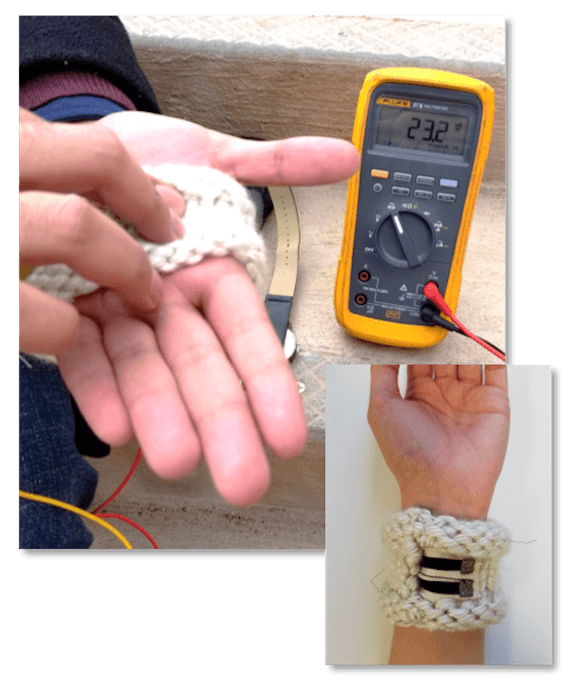Jan 23 2019
According to Trisha Andrew, a materials chemist at the University of Massachusetts Amherst, the majority of data transmitters, wearable biosensors, and analogous tech developments in personalized health monitoring have currently been “creatively miniaturized.”
 Materials chemists led by Trisha Andrew have developed a fabric that can harvest body heat to power small wearable microelectronics such as activity trackers. (Image credit: Photo courtesy UMass Amherst/Andrew lab)
Materials chemists led by Trisha Andrew have developed a fabric that can harvest body heat to power small wearable microelectronics such as activity trackers. (Image credit: Photo courtesy UMass Amherst/Andrew lab)
Despite this, they still need plenty of energy, and power sources can be rather heavy and bulky. Now, Andrew and her PhD student Linden Allison have reported that they have created a novel fabric that can power tiny wearable microelectronics, like activity trackers, by harvesting body heat.
Andrew and Allison, writing in an early online edition of Advanced Materials Technologies, explained that theoretically, body heat has the ability to generate power by exploiting the variation between ambient cooler air and body temperature—the so-called “thermoelectric” effect. Materials that have low thermal conductivity and high electrical conductivity can shift electrical charge from a warm area towards a cooler one in this manner.
Some studies have demonstrated that it is possible to harvest small amounts of power from a human body over a workday of eight hours; however, the duo pointed out that unique materials that are presently required are too costly, inefficient, or toxic.
What we have developed is a way to inexpensively vapor-print biocompatible, flexible and lightweight polymer films made of everyday, abundant materials onto cotton fabrics that have high enough thermoelectric properties to yield fairly high thermal voltage, enough to power a small device.
Trisha Andrew, Materials Chemist, University of Massachusetts.
For this study, the team leveraged the cotton and wool’s naturally low heat transport characteristics to produce thermoelectric garments that have the ability to preserve a temperature gradient across an electronic device called a thermopile. This thermopile changes heat to electrical energy even after extended periods of continuous wear. Andrew noted that this is a practical consideration to make sure that the conductive material is going to be thermally, mechanically, and electrically stable over time.
“Essentially, we capitalized on the basic insulating property of fabrics to solve a long-standing problem in the device community,” Andrew and Allison summarized. “We believe this work will be interesting to device engineers who seek to explore new energy sources for wearable electronics and designers interested in creating smart garments.”
To develop the all-fabric thermopile, the researchers specifically vapor-printed a conducting polymer called persistently p-doped poly(3,4-ethylenedioxythiophene) (PEDOT-Cl) onto one medium-weave and one tight-weave form of commercially available cotton fabric. They subsequently incorporated this thermopile into a uniquely engineered, wearable band that produces greater than 20 mV thermo-voltages when worn on the hand.
To test the sturdiness of the PEDOT-CI coating, the researchers laundered or rubbed the coated fabrics in warm water and then evaluated the performance through scanning electron micrograph, which revealed that the coating “did not crack, delaminate or mechanically wash away upon being laundered or abraded, confirming the mechanical ruggedness of the vapor-printed PEDOT-CI.”
Then, using a custom-made probe, they determined the coatings’ surface electrical conductivity and discovered that the looser weave cotton showed higher conductivity when compared to the tighter weave material. The conductivities of the two fabrics “remained largely unchanged after rubbing and laundering,” they added.
The researchers used a thermal camera to establish that the upper arms, palm, and wrist of volunteers radiated the largest amount of heat. Therefore, stretchy knitted bands of thermoelectric fabric were subsequently developed by the team to be worn in these areas. The thickness of the yarn ensures that the air-exposed outer side of the band is protected from the body heat, whereas the thermopile’s uncoated side alone contacts the skin to decrease the risk of allergic reaction to PEDOT-CI, the researchers pointed out.
They observed that perspiration considerably increased the armband’s thermovoltage output, which was expected because damp cotton is a better heat conductor when compared to dry fabrics. The researchers also inserted a heat-reflective plastic layer between the band and the wearer’s skin to turn off heat transfer at will.
On the whole, they stated that, “We show that the reactive vapor coating process creates mechanically-rugged fabric thermopiles” with “notably-high thermoelectric power factors” at low-temperature differentials as opposed to conventionally developed devices. “Further, we describe best practices for naturally integrating thermopiles into garments, which allow for significant temperature gradients to be maintained across the thermopile despite continuous wear.”
The National Science Foundation and the David and Lucille Packard Foundation supported the study.